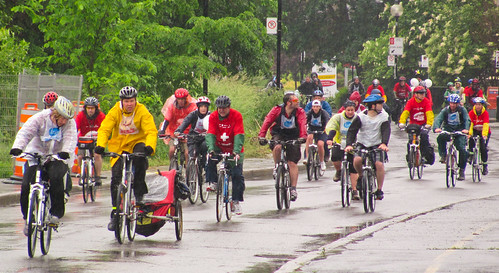More bikes: Elements of a Bicycle-Friendly Community
In the previous entry, I forgot to include a link to the section on Elements of a Bicycle-Friendly Community from the Bike San Gabriel Valley (BikeSGV) website.
While I would re-order the list (see below), it's a very good overview, one I'd have been proud to put together myself. (Also see "Best practice bicycle planning for suburban settings using the 'action planning' method," "What should a US national bike strategy plan look like?," and "Ideas for making bicycling irresistible in Washington DC.")
The list is more about the experiential quality of biking for transportation as compared to the more quantitative focus of the League of American Bicyclists criteria for the Bicycle Friendly Community recognition program. (LAB has parallel recognition programs for campuses and businesses.)
The BikeSGV list:
1. GREEN & PROTECTED BIKE LANES
2. SIGNAGE
3. BIKES ON PUBLIC TRANSIT
4. BIKE PARKING FACILITIES
5. BIKE STATIONS/HUBS/CO-OPS
6. BIKE SHARING/RENTALS
7. BICYCLE EDUCATION & AWARENESS
8. BIKE-FRIENDLY BUSINESS DISTRICTS (BFBD)
9. BIKE-RELATED BUSINESSES
10. COMMUNITY BIKE FESTIVALS
Elements I'd add:
- SUPPORT FOR BICYCLE SHOPS
- PRINTED MAPS/brochures, for the city, county, and local districts--for local districts, not unlike the maps used at bike share stations. To save money, more agencies are cutting back on printing maps, but I disagree, as printed items are also marketing and promotion devices.
- POSTING MAPS and BIKE PROMOTION MATERIALS in public places including transit stations
- EQUITY PROGRAMS THAT PROVIDE ACCESS TO BIKES TO OTHERWISE UNDER-PARTICIPATING DEMOGRAPHICS (programs by the Community Cycling Center of Portland and Boston Bikes are good models)
- TRANSPORTATION DEMAND MANAGEMENT PROGRAMS THAT PROMOTE BICYCLING AS TRANSPORTATION FOR BUSINESSES, SCHOOLS, AND CAMPUSES
- SUPPORT FOR BICYCLE TOURISM, including brochures and information at visitor centers
BIKE PARKING FACILITIES should be termed BIKE PARKING AND SUPPORT FACILITIES and include air and repair stands. They cover that as part of BIKE STATIONS/HUBS but air and repair needs to be more available, especially with the closure of gas stations (air pumps) in cities (not to mention they make you pay for the air).
Plus, COMMUNITY BIKE FESTIVALS and COMMUNITY BIKE RIDES should be held at various scales: neighborhood; council districts; entire city, and include OPEN STREETS EVENTS (the CicLAvia events in Los Angeles are probably the nation's most successful). The Utah Transit Authority sponsors a Bike Expo each year, etc.
WRT COMMUNITY BIKE RIDES, VéloQuébec's Tour de L’Île de Montréal and the kinds of bike rides done by KidicalMass groups are a better model for promoting biking as transportation and participation, as opposed to rides that are more focused on higher speed recreational riders.
From the Guardian article "People power: the secret to Montreal's success as a bike-friendly city":
...cyclists are nonetheless massing in the city’s Jeanne-Mance Park. Lots of them – about 30,000, in fact. Some are dressed in Lycra with lightweight road bikes, but the majority are wearing everyday clothes, many with children, either riding their own tiny machines or on one-wheeled add-ons to a parent’s bike, even toddlers strapped into trailers.
It is the start of the Tour de L’Île, an annual mass ride with routes of anything from 18 to 60 miles through streets closed to vehicle traffic for the day. It is both a celebration of Montreal’s unlikely bike culture and a yearly reminder to its politicians and officials of how numerous and varied is the local two-wheeled population.

Flickr photo of the 2010 Tour de L’Île de Montréal by Anirudh Koul.
Such rides are good ways to communicate that "Bikes Belong" in a mobility environment that still preferences automobility, even in cities., much better than the occasionally violent Critical Mass rides ("SF District Attorney Gascón blasts suspect in Critical Mass attack," San Francisco Chronicle)
Labels: action planning, bicycle and pedestrian planning, car culture and automobility, transportation planning



1 Comments:
This post shares information about bicycle-friendly communities.
Bicycling is more than a reasonable, practical answer for some city challenges. It's a chance to make your locale a dynamic goal for inhabitants and guests — a spot where individuals don't merely live and work, yet flourish.
Post a Comment
<< Home